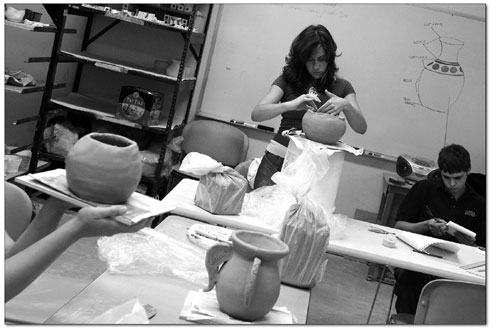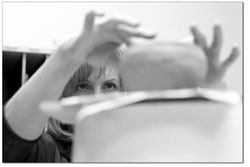|
| ||||
| Finding the way with clay
by Jules Masterjohn Last Saturday at the downtown Coffee Festival, the Pueblo Community College booth was definitely a hit with the crowd. The big attraction: a pottery demonstration. I recognized the craving in each wide-eyed adult as they approached the spinning potter's wheel, and it was no different for the children. There is something completely compelling about working with clay. Some "get bitten by the clay bug" while others "catch the ceramic virus." I fell prey to the likes of it in 1976 during my first year in college. Today, 30 years later, I watch my students succumb to its charms. We "mud people" - those of us who have actually eaten clay, not on a dare but because we like the salty taste - are a small percentage of the population. Yet it seems that nearly everyone has some fondness for getting his or her hands dirty. The attraction is old. Humans have been making ceramic objects for more than 8,000 years, and working with it touches something essential in our humanness. The Bible makes many references to a metaphorical bond between humans and clay: "God is the potter, we are the clay." Is it our inner desire to "play God" that draws us to manipulating the fine-grained plastic earth - or perhaps a reference to the innate creativity of our human nature. A geologic and physiological association exists also. Look at the label on any multivitamin bottle and it reads like a list of ceramic raw materials. Our bodies need minerals like iron, manganese and calcium to survive. These very same minerals are elements in ceramic glazes and clay bodies. We are the earth, it seems. The emotional aspect of the relationship is most illuminating. I have noticed that clay, with its totally malleable qualities, is a great teacher, offering students important lessons about themselves. If there is a chink in one's armor, a few months working with clay and the rift will be exposed. The clay reveals to us our strengths and weaknesses. Curious about other's perceptions of the human/ceramic connection, I talked with students in the ceramics class I teach at Pueblo Community College.
As I walked over to Kyla Norcross, I could see that she was struggling. Obviously, her teacher (the clay, not me!) was presenting a demanding lesson. As she added more coils of clay to her already sizable vessel, I heard her say under her breath, "This is breaking me." Kyla was a bit under the weather that day, having picked up a bug from her 8-year old daughter, so the clay's teaching was especially challenging. "I feel like the clay is molding me instead of the other way around," she offered in an exasperated voice. "I had a vision of what it should look like, but it's like the pot has a mind of its own." It has been 17 years since Kyla has worked with clay, though she is an avid creator using collage, pencil, marker and paint. "Working with clay is really different than painting," she explained. "When I paint, I get a vision in my head and paint it. With ceramics, my hands are more involved … it's so tactile and such a moment-by-moment experience. I really have to use my brain differently." Kyla's frustrations aside, she is thoughtful about her experience. "All of the arts bring me joy. I know I'll never be a professional artist, but the creative stuff nourishes my soul. It's just part of who I am." Kyla is not a traditional student. Pursuing an associate of arts degree, she is a full-time mother and wife, and also holds down a 30-hour-a-week job. Yet, like many other traditional students, she takes art classes to balance her "cerebral" classes, helping to ease the heavy load on her logical mind. Her creative activities keep her inspired to learn. Like Kyla, Marie McCallum is familiar with expressing her creative energy. A realistic oil painter and muralist, Marie paints nearly every day. "When I paint, I get all my colors mixed and tools prepared ahead of time. With ceramics, I have no plan. I just sit down and make something. It's a nice change from painting." Siblings Valerie and Melissa Blaine work side by side at a table. They started taking art classes together when they were youngsters but haven't taken any together since high school. It was an unexpected teaching aid to have biological sisters enrolled: the first class project is to make three vessels that share a family resemblance, like the Blaine sisters' dark and intense eyes. When I asked Melissa what intrigues her about clay, she answered immediately and deliberately, as if she had given this question serious thought. "I am the follower in the relationship with the clay. It's frustrating because the clay is so willful yet I like that it makes me let go of control and just go with it. This is not like painting. Clay has its own breath and life." Lynn Honig had no difficulty deciding what physical trait her family of pots would share. "A very big, round belly," she said as she patted her 8-month pregnant stomach. A first-year student and a newcomer to ceramics, Autumn Santiago observed that working with clay is harder than it looks. "After awhile, you can feel it in your hands and it all comes together. It is very soothing and a good way to clear your mind." Working with a calm intensity, she methodically rolls each coil of clay out, placing one on top of the other, and smoothes the coils together. For a first encounter with clay, she seems like a natural, confident with her new techniques and tools. As an instructor, I enjoy watching students gain skills, make decisions, challenge themselves and achieve goals. Success is often redefined in the learning process with clay. It seems that clay offers an experience that is rare in life. With each ceramic vessel we make, we recreate ourselves in a new form. Ceramics offers a metaphor for living. • Pueblo Community College is located at 701 Camino del Rio, Suite 100. For information on class offerings, call 247-2929.
|



